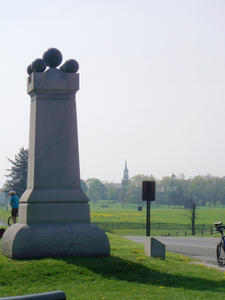Advertisement
Published: August 6th 2007

 The Opening Shots
The Opening Shots
This statue is to the Artillery unit that fired the first shots. If you look in the background you can see the cupola that was used by the Generals to observe the first day of the battle (also the one used in the movie). G'day All, hope things are well back home. The latest installment in our travels was a trip to Washington DC. Once a year the Australian Embassy get all the Army guys posted to the States together at DC for briefs and a bit of a social gathering (Navy and Air Force do the same on different weeks). I decided I would head up a couple of days before Fiona to participate in the social aspects of the week (aka - get on the turps), so I left last Sunday and stayed with Jacko a friend of ours living in DC (he is also the same bloke we went to Las Vegas with). We had a formal dinner on Monday night which was followed up by an organised tour of the Gettysburg battlefield on Wednesday. Fiona had some work to do so she decided to fly up Wednesday night after all the Army week festivities had concluded.
DISCLAIMER: We've decided to split the posts into two for this trip - this post on the Gettysburg Tour and the next one will cover the rest of DC. This is to make sure that we don't bore anyone stupid, so read on if

 Learning how to fight Civil War Style
Learning how to fight Civil War Style
Here's our crazy tour guide dressed as a Confederate Officer leading us across one of the battlefields.you are a bit of a history buff or you are interested at all in Gettysbug. If you're not interested in the Civil War I'd skip to the next entry.
Anyway, the Embassy arranged for two Historians to provided a guided tour of the Gettysburg battlefield. This included about 2 hours of briefs the day before to make sure everyone had an understanding of the significance of the battle, why and how it was fought. For those of you who aren't familiar with Gettysburg, it is considered to be the most important battle during the American Civil War. The North were pretty much on the verge of defeat but managed to pull out a victory which turned the tide of the war. The battlefields here are considered to be the most hallowed ground in America and thousands upon thousands of tourists visit every year.
Anyway, the two blokes providing the tour would have to be the most passionate guys I have ever met. They obviously enjoyed educating us Aussies on the Civil War and they went to great lengths to ensure it was an enjoyable day. One of the guides had four of five different Civil War Uniforms

 Australians at Gettysburg
Australians at Gettysburg
This is a monument to a New York unit in which an Australian fought. I'm not sure if he survived the war or not, but apparently there were at least six Australians who fought a Gettysburg.complete with swords, binoculars, drink bottles etc. He continually got changed throughout the tour to assume different characters at each location to help explain the story of each battle. He put on accents and the whole time he talked to us about specific parts of the battle he didn't break out of character at all - it really was a great way to conduct the tour and made the battlefield really come to life. And boy did he know the battlefield in depth - what he didn't know just wasn't worth knowing.
We were lucky enough to visit all the key locations of the battle including Little Round Top where a Northern unit that was out of ammunition conducted a bayonet charge down a hill and saved the day (if you've seen the movie Gettysburg you'll know what I'm talking about). The highlight of the tour was walking the ground of Pickett's Charge. If you haven't heard of it before it was the final charge made by the Southern Army on the last day of the battle. The charge was a frontal assault made across 1500 meters of open ground - needless to say they got absolutely massacred. To

 Little Round Top
Little Round Top
This photo is taken on Little Round Top where Colonel Chamberlain lead a bayonet assault charge and successfully defended the Union flank. He won a Medal of Honour for his conduct.stand on that ground and develop an understanding of the courage it must have taken to charge across that ground was quite a humbling experience. What also struck home was that most people living in the US had numerous relatives that fought in the war on both sides - so the Civil War holds as much importance for Americans as Gallipoli does for Australians.
I've posted a fair few photos - mostly because I know Ian will be interested, but it was also a pretty amazing place to walk around.
Advertisement
Tot: 0.231s; Tpl: 0.011s; cc: 14; qc: 64; dbt: 0.1029s; 1; m:domysql w:travelblog (10.17.0.13); sld: 1;
; mem: 1.2mb

 The Opening Shots
The Opening Shots
 Learning how to fight Civil War Style
Learning how to fight Civil War Style
 Australians at Gettysburg
Australians at Gettysburg
 Little Round Top
Little Round Top








